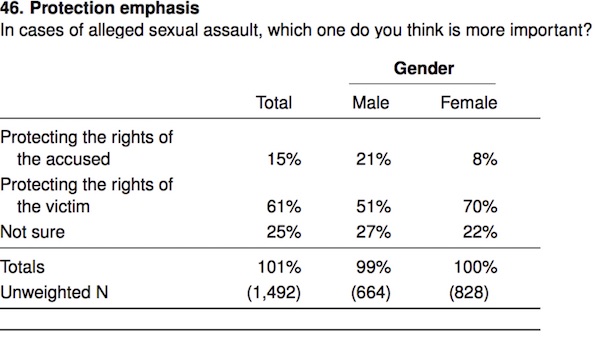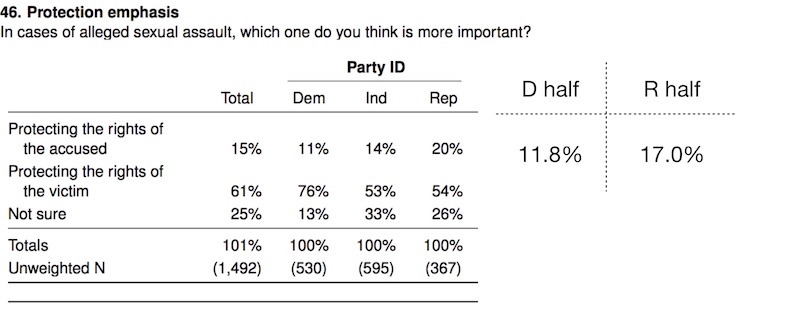There is more to the Gender Gap than the Partisan Divide
A recent post at fivethirtyeight.com reaches a conclusion that is plainly false. This is no doubt an honest mistake caused by some mixture of haste, confirmation bias, and careless overstatment. There is no reason to suspect any conscious intent to mislead; no justification for ad hominem attacks on the author.
What matters are the facts. The facts here bear on profoundly important personal experiences and equally important collective decisions. It would be inexcusable to let false statements about such facts go unchallenged or to let false claims divert attention from the question that matters: “Is the gender gap on questions about sexual harassment and assault a sign that women have a better grasp on the facts?”
The title of the post summarizes the first step in its argument:
The Biggest Divides On The Kavanaugh Allegations Are By Party — Not Gender
It justifies this claim using responses to a question (#9) from a recent HuffPost/YouGov poll, which asks whether the allegation of sexual assault against Brett Kavanaugh is credible. For this question, the difference between the average response of Democrats and Republicans is larger than the difference between the average response for men and women.
The best one can say about this comparison is that it is careless. Its measure of the partisan divide suffers from an obvious upward bias relative to the measure of the gender gap because it excludes the responses of independents. Leaving out these centrists will automatically increase the difference between the two groups that remain. The effect is big because there are lots of independents. For this particular poll and in round numbers, 600 of the 1500 respondents do not provide a party affiliation. (The second table below has the details.)
The post crosses over from assertions that are careless to ones that are false when it generalizes:
“… this pattern — a bigger split by party than by gender — is not just seen in heavily partisan situations, …”
“Even on gender issues more broadly, the partisan divide outstretches the gender one.”
The conclusion of the post, stated in the second quoted sentence, is objectively false.
Another question from the same poll, #46, shows that it is false. It refers to general “cases of alleged sexual asset” and solicits a choice: “Is it more important to protect the rights of the accused or the rights of the victim?” The answers reveal a gender gap that is substantially bigger than a measure of the partisan divide that includes the independents, bigger even than the measure of the divide that excludes them.
It will come as no surprise that a larger fraction of men than women say that it is more important to protect the rights of the accused. The first line of the first table below shows that 21% of men select this respond versus 8% of women.

The first line of the next table shows that Republicans are also more likely than Democrats to prioritize the rights of the accused (20% for Republicans versus 11% for Democrats.) This 9 percentage point difference is already smaller than the 13 percentage point gender gap. Moreover, as expected, the value for the excluded independents (14%) lies between the values for the two parties.

To be comparable with the gender gap, a measure of the partisan divide must take the difference between two groups that include everyone. A natural way to do this is to divide up the independents and group them with one party or the other to end up with R and D leaning halves of the sample with same number of respondents (746). For each, the percentage of respondents who prioritize the rights of the accused is a weighted average of the percentage for its party and the 14% value for the independents, with weights that are proportional to the shares of the party members and the independents.
The numbers to the right on the first line of second table show by how much this measure pulls the values for the two parties toward the 14% value for the independents. There are still more in the R half than the D half (17% versus 12%), but now the partisan divide is 5 percentage points, down from 9 for the measure that excludes the independents.
Caveats and Conclusions:
-
Compared to an ideal measure, my split into halves is likely to be less biased than the one that excludes the independents, but biased nevertheless, in the other direction. In effect, my calculation allocates the independents randomly to the R and D sides. A better approach would be to use information about how each independent leans to assign them to the two parties. This poll does not provide the information required to do this, so the safe approach is to treat the two measures of the partisan divide (5 percentage points and 9 percentage points) as bounds on the true value. This safe approach still shows that the answers to this question show that post’s conclusion is false. For any value in this range, the partisan divide is smaller than the 13 percentage point gender gap.
-
Both the partisan divide and the gender gap will vary across survey questions, so it is all too easy to “cherry-pick” questions that yield a desired result. This is why the other specific examples cited in the post, offered as support for its sweeping generalization, are not persuasive. Nor would they offer persuasive support for some narrower claim: “For {lots of, most, many, …} survey questions, the partisan divide outstretches the gender gap.” A convincing analysis would have to examine all such questions or a subset that is selected in a truly random fashion.
-
I used one specific question about the rights of the accused and the victim in cases of alleged sexual assault to show that for at least one question, the partisan divide is unambiguously smaller than gender gap. If we agree that sexual assault is a “gender issue,” this is all it takes to contradict the assertion that “on gender issues more broadly, the partisan divide outstretches the gender one.”
-
If my argument leaves you with the urge to denounce my hypocrisy in looking at one specific question, hence engaging in precisely the sort of cherry picking that I warn against, pause to think about the logic. It takes only one counter-example to disprove any assertion of the form “for all x, P(x) is true.”
-
By challenging the post’s answer to its “which-is-bigger” question, I am not endorsing its premise, that “which-is-bigger” is an interesting or important question. In the context of the discussion that is underway about the difference between the lived-experience of men and women, it would be more productive to start by asking, “Which (if any) types of survey questions reveal a quantitatively significant gender gap?” The obvious way to pursue this question would be to calculate the difference between the responses women and men who are Republicans; the same difference for Democrats; and of course this same difference for the independents. There are, no doubt, polls that allow these comparisons and calculations about the size of each difference. (If you know of any, especially those with questions about sexual harassment and sexual assault, post links where others can find them. You could try to send me a tweet, but hostile actors can easily overwhelm it with noise. If I do not acknowledge with a retweet, I probably have not seen it.)
-
I suspect that there is already good evidence for a gender gap on questions about sexual harassment and assault. If not, I predict that researchers will reach a consensus that there is a gender gap on at least these questions that will be easier to assess if we take out the partisan noise. If so, the important question is “Why is there a gender gap on these questions?”
-
The explanation to this question that deserves serious scientific consideration is the one that the women who have spoken up have offered over and over again without being heard: Women respond differently to questions about sexual harassment and assault because they have a better grasp on the facts. Compared to men, an astonishingly large fraction of women have relevant personal experience that they can never forget.